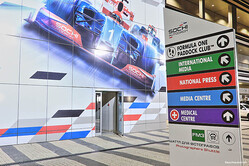


07/10/2014
NEWS STORY
 The P Zero White medium and P Zero Yellow soft tyres have been chosen for Russia: a combination that was last seen at the Belgian Grand Prix
The P Zero White medium and P Zero Yellow soft tyres have been chosen for Russia: a combination that was last seen at the Belgian Grand Prix
Formula One heads into new territory with the brand new Sochi circuit near the Black Sea in Russia: the home of the 2014 Winter Olympic games. This will be the first new circuit introduced to the grand prix calendar since Austin in 2012.
With the track only having been recently completed, there is not a lot of real data available. However, Pirelli has carried out advanced computer simulations in collaboration with the teams to prepare for the demands of a new venue and predict the likely strategies.
As a result, the P Zero White medium and P Zero Yellow soft tyres have been chosen for Russia: a combination that was last seen at the Belgian Grand Prix in Spa.
Sochi is a medium-speed circuit with a variety of different corners, including one left-hander that has been inspired by the long triple apex Turn 8 at Istanbul Park, which takes an enormous amount of energy out of the front-right tyre. In total there are 12 right and six left-hand corners, with a 650-metre straight between the first and second turns, on which the cars are expected to hit a top speed of around 320kph. The average lap speed will be in the region of 215kph, with the track layout designed by renowned circuit architect Hermann Tilke, whose last F1 creation was Austin in Texas.
Paul Hembery: "Russia is a key territory for Pirelli, along with all the major automotive companies in the world, so we are very much looking forward to Sochi and the first Russian Grand Prix, which is a significant milestone in the sport's history. From a tyre perspective it should be an interesting challenge; we've got a wide variety of corners that should test every aspect of performance. As has been the case at every grand prix this year, we're aiming for between two and three pit stops per race and the nomination we have made reflects this. In terms of overall tyre energy demands, Russia is somewhere in the middle, and measurements also indicate low-abrasion asphalt. Regarding the weather, initial forecasts suggest that conditions will be temperate. Going to a new circuit is always exciting and it's only when we get there that we will have a complete idea of what to expect, so the work done in free practice will be particularly important for everyone."
Jean Alesi, Pirelli consultant: "With the simulation technology that exists now, it's much easier for drivers, teams and of course tyre companies to prepare for a new grand prix than it was in my day. But there is still a big difference between virtual and reality: simulation can never replicate everything. So it will be important for the drivers and engineers to inspect the track carefully; to understand the nature of the surface you have to touch it and feel it. On the first day in particular the track will be very dirty and difficult to drive, which makes it quite hard to get the right idea about set-up and the characteristics of the tyres. With no previous information, it's easy to misunderstand things or go in the wrong direction on set-up, which only adds to the challenge of a completely new venue."
The circuit from a tyre point of view:
Sochi is not especially similar to any of the current Formula One tracks, but it has some characteristics in common with the Valencia street circuit used up until 2012. Just like Montreal and Melbourne, Sochi is a semi-permanent facility, and it has something else in common with Montreal too, running around a former Olympic venue.
The medium tyre is a low working range compound, capable of achieving optimal performance even at a wide range of low temperatures. The soft tyre by contrast is a high working range compound, suitable for higher temperatures. Ambient temperatures ranging from 15-20 degrees centigrade are common for Sochi at this time of year.
One of the reasons why new asphalt is so slippery is that the oils used to make the bitumen rise to the surface, almost creating an invisible film on the top of the track. With time, these oils are wiped off and the surface eventually becomes more abrasive. If it rains – which is by no means impossible at this time of year – the track is especially treacherous.
The 5.853-kilometre track will be the third-longest of the year, behind Spa and Silverstone. Around 1.7 of those kilometres are run on public roads, and the race will run for 53 laps.